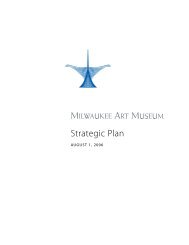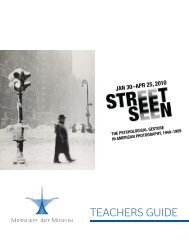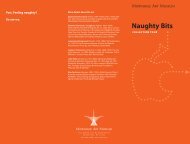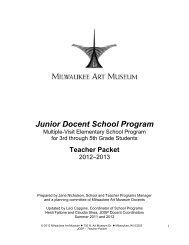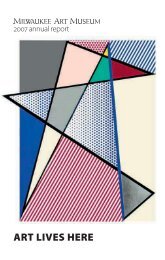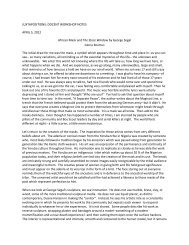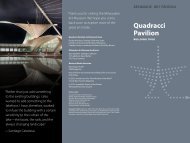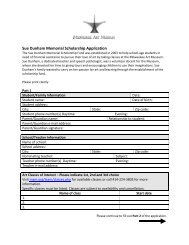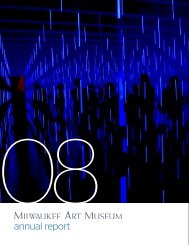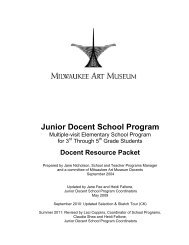Jan Lievens: A Dutch Master Rediscovered - Milwaukee Art Museum
Jan Lievens: A Dutch Master Rediscovered - Milwaukee Art Museum
Jan Lievens: A Dutch Master Rediscovered - Milwaukee Art Museum
Create successful ePaper yourself
Turn your PDF publications into a flip-book with our unique Google optimized e-Paper software.
fig. 3. Boy in a Cape andTurban, c. 1631, oil on panel.Private collectionlectuals, is one clue that the sitter is a charactertype rather than an individual.In contrast to the old man’s modestattire, many tronies were dressed in ornate“oriental” clothing similar to that wornby the figure in Boy in a Cape and Turban,c. 1631 (fig. 3). <strong>Lievens</strong> spared no detailsin rendering the sumptuous fabric and lavishaccoutrements, conveying the sheen ofthe stiff cape and glint of golden chain, thetight folds of the patterned turban, and thesoft wisps of plume. The finery is redolentof pomp and potency, yet the features ofthe lad’s milky face are sensitive and adolescent,expressing a hesitancy that beliesthe grandeur. At times the line between aportrait and a tronie is difficult to define,and Boy in a Cape and Turban may in factbe something of a mixed genre, a portrait of a princely sitter dressed in exoticgarments. Like tronies, costumed portraits appealed to the taste of noblepatrons. <strong>Lievens</strong> likely specialized in such splendid pictures with an eyetoward becoming a court painter.lievens and rembrandtThe exact nature of <strong>Lievens</strong>’ relationship with Rembrandt, who was a yearolder and also grew up in Leiden, is unknown. But the extent to which theirinterests and styles converged in the 1620s reveals their close association. Insubsequent centuries, their affiliation would be framed as though <strong>Lievens</strong>were a student of Rembrandt or a member of his circle a misperceptionreinforced by the attribution of a number of <strong>Lievens</strong>’ works to his Leidenfriend and colleague (including The Feast of Esther, fig. 1). In fact, <strong>Lievens</strong>was already establishing his career when Rembrandt began his training (alsowith Lastman in Amsterdam). The two subsequently learned from eachother, with <strong>Lievens</strong> initially leading the way. They adopted some of the sameinnovative techniques (for example, both used the blunt end of a brush handleto scratch details in wet paint, as in <strong>Lievens</strong>’ Bearded Man with a Beret);
fig. 4. Job in His Misery,1631, oil on canvas. NationalGallery of Canada, Ottawa,Gift of National <strong>Art</strong> CollectionsFund of Great Britain,1933 (at left)fig. 5. Rembrandt van Rijn,Jeremiah Lamenting theDestruction of Jerusalem,1630, oil on panel. Rijksmuseum,Amsterdam(at right)not in exhibitionoften used the same models, including one another; and frequently took upthe same or analogous subjects. By the early 1630s confusion had alreadyrisen over the attribution of their work.Pensive, elderly figures fascinated both artists. <strong>Lievens</strong>, in his masterfulJob in His Misery, 1631 (fig. 4), concentrated on the sagging flesh and utterabjection of the Old Testament protagonist whom God allowed Satan to tormentas a test of his faith. Job, his arms slack, his head bowed in resignation,slumps in a state of wretchedness, yet is still unwilling to blame God for hissuffering. <strong>Lievens</strong>’ painting is comparable to Rembrandt’s 1630 treatmentof an equally dejected, bearded, biblical character: the prophet Jeremiah,whose warnings about the impending destruction of Jerusalem wentunheeded (fig. 5). Taking up corresponding themes may have involvedmore than just a friendly rivalry, for it is possible that Huygens, who knewand admired both artists, sought to stimulate their competition and theirimaginations by requesting that each interpret a particular topic.One area in which <strong>Lievens</strong> and Rembrandt certainly challenged eachother was printmaking. Both artists exploited the technique of etching,developing innovative means to create images akin to freehand sketching;
fig. 6. The Raising ofLazarus, 1630 – 1631, etchingand engraving, state 3 (of 3).Rijksmuseum, Amsterdam(at left)fig. 7. Old Man Facing Forward,c. 1630 – 1631, etching,state 1 (of 3). Rijksmuseum,Amsterdam (at right)both also explored the effects of light and dark in their prints. AlthoughRembrandt’s fame as a printmaker today exceeds that of any other <strong>Dutch</strong>artist, <strong>Lievens</strong>’ prints were also highly valued in the seventeenth century even by Rembrandt, who acquired and copied several of them. One subjectthe two artists explored in prints was the biblical story of Lazarus’ deathand resurrection. The Raising of Lazarus, 1630 – 1631 (fig. 6), an etching by<strong>Lievens</strong> that is grand in size and effect, was based on his critically acclaimedpainting of 1631 (which Rembrandt acquired). The highly original compositionshows Jesus standing in prayer above the tomb. At that very momentLazarus’ hands begin to reach up, to the astonishment of onlookers thatinclude his sisters Mary and Martha.In printmaking as in painting, <strong>Lievens</strong> and Rembrandt were drawn tothe physical and psychological effects of old age, with wrinkles and wearinesscarved into a face by years and experience. In Old Man Facing Forward,c. 1630 – 1631 (fig. 7), an example of the type of tronie the artists excelled increating, a variety of etched lines vividly evokes the scratchiness of fur andthe crevices and imperfections of aging skin. Rembrandt made a copy of it in1635, several years after both artists had departed Leiden an indication ofhis continued interest in his friend’s work.
fig. 9. The Lamentationof Christ, c. 1640, oil oncanvas. Bayerische Staatsgemäldesammlungen,Munich, Alte Pinakothekmay have painted this work in the manner of Brouwer as a tribute to hisdeceased friend.The painting’s squat, loutish characters are far removed from the directionthe artist eventually took. In London <strong>Lievens</strong> had come under theinfluence of Van Dyck and his elegant manner of painting, embracing itwholeheartedly only after his move to Flanders. The Lamentation of Christ,c. 1640 (fig. 9), captures the mood and character of Van Dyck’s depictionsof Mary grieving over the crucified Jesus. In <strong>Lievens</strong>’ painting the poignancyof the scene is underscored by the Virgin’s mournful yet tender gaze at herdead son. Cradling him, she places his crown of thorns on a silver platterheld by Joseph of Arimathea. The graceful gestures, emotional intensity,rich coloring, and softly modulated forms rendered with broad brushstrokesare hallmarks of the courtly style perfected by Van Dyck. Favored by internationalcollectors, it served <strong>Lievens</strong> well for many years, bringing him theprofessional success he craved.return to the netherlandsDespite the high prices <strong>Lievens</strong> commanded in Antwerp, financial difficultiesled him to move to Amsterdam in 1644. Once there he quicklyestablished himself as one of the city’s leading artists. Much of <strong>Lievens</strong>’ laterwork counts among the most prestigious of his career, including projects todecorate rooms for the Prince of Orange in The Hague and the Elector ofBrandenburg in Germany. One particularly ambitious canvas, Triumph of
Peace, 1652 (fig. 10), is an allegorical commemoration of the Treaty of Münster,which ended decades of conflict between the Netherlands and Spainin 1648. Like many of <strong>Lievens</strong>’ late paintings, Triumph of Peace draws onthe classical world for its complex iconography. In the midst of its swirling,bursting composition, Minerva, goddess of wisdom, crowns Pax (peace), thesumptuously dressed woman who holds an olive branch and sits in triumphover Mars, god of war.Demand for <strong>Lievens</strong>’ portrait drawings and paintings was high inAmsterdam. His reputation ensured an impressive list of distinguishedsitters, both local and international, such as the French philosopher RenéDescartes and Sir Robert Kerr, First Earl of Ancram. The likeness of Kerr,from 1654 (fig. 11), is an affecting depiction of a once powerful man reducedto poverty and exile at the end of his life. Loyal to Charles I, the earl hadfled England upon the king’s beheading in 1649, living his few remainingyears in Amsterdam. <strong>Lievens</strong> brilliantly captured the mixture of regret anddetermination in Kerr’s frail face. The dark tonality points to the artist’s continuedassimilation of local painting traditions, as he tempered the grandeurof the international style he had cultivated to accommodate the preferencefig. 10. Triumph of Peace,1652, oil on canvas. Rijksmuseum,Amsterdam
fig. 11. Sir Robert Kerr, FirstEarl of Ancram, 1654, oil oncanvas. Private collection, onlong-term loan to the ScottishNational Portrait Galleryfig. 12. Forest Interior witha Draftsman, 1660s(?), penand brown ink and brownwash. Maida and GeorgeAbrams Collection, Boston,Massachusetts, on loan toFogg <strong>Art</strong> <strong>Museum</strong>, HarvardUniversityin Holland for a more restrained, thoughequally refined, manner.An enduring preoccupation for <strong>Lievens</strong>after moving to Amsterdam was the depictionof nature. One of his most strikinglandscape drawings is Forest Interior witha Draftsman, 1660s(?) (fig. 12). Althoughprobably begun outdoors, this work waslikely completed in the studio, intended to besold. The sense of space and vivid renderingof nature’s intricacies with a variety of penstrokes demonstrate the exceptional powerof <strong>Lievens</strong>’ draftsmanship. Like many of hisfinished landscape drawings, it was executedon imported oriental paper. <strong>Lievens</strong> wasamong the first to experiment with the various effects of this paper’s remarkablyfine, smooth surface.In the last two decades of his life <strong>Lievens</strong> moved several more times, fromAmsterdam to The Hague, to Leiden, and finally back to Amsterdam. Despitehis relocations, the artist continued to find a successful market for his paintings,prints, and drawings. Yet more financial mismanagement left him deeplyin debt when he died. His reputation, though still high, began its descentwithin a few decades. In recent years, as new information has encouragedreconsideration of <strong>Lievens</strong>’ place in <strong>Dutch</strong> art, the distinctive contributionsof this versatile and fascinating artist can finally be acknowledged.
CONCERTSOctober 29, 12:10 pmWest Building Lecture HallMusica ad RhenumNovember 2, 6:30 pmWest Building,West Garden CourtNational Gallery of <strong>Art</strong>Vocal <strong>Art</strong>s EnsembleGALLERY TALKSPlease consult the Calendar ofEvents or www.nga.gov for fullschedule and program information.SUNDAY LECTURESEast Building AuditoriumOctober 26, 2:00 pm<strong>Jan</strong> <strong>Lievens</strong>: Out ofRembrandt’s Shadow<strong>Art</strong>hur K. Wheelock Jr., Curatorof Northern Baroque Paintings,National Gallery of <strong>Art</strong><strong>Jan</strong> <strong>Lievens</strong> in Black and White:Etchings, Woodcuts, and Collaborationsin PrintStephanie S. Dickey, Bader Chairin Northern Baroque <strong>Art</strong>, Queen’sUniversityON THE WEBThe Gallery’s Web site featuresselected highlights from theexhibition and links to exhibitionrelatedactivities at: www.nga.gov/lievens.CATALOGUEThe exhibition is accompaniedby a fully illustrated, 320-pagecatalogue, <strong>Jan</strong> <strong>Lievens</strong>: A <strong>Dutch</strong><strong>Master</strong> <strong>Rediscovered</strong>, by exhibitioncurator <strong>Art</strong>hur K. Wheelock Jr.,with essays by Stephanie S.Dickey, E. Melanie Gifford,Gregory Rubenstein, Jaap vander Veen, and Lloyd DeWitt.Produced by the National Galleryof <strong>Art</strong> and published in associationwith Yale University Press.Hardcover 65.00Softcover 45.00GENERAL INFORMATIONHoursMonday – Saturday,10:00 am – 5:00 pmSunday 11:00 am – 6:00 pmGallery Web site: www.nga.govFor information about accessibilityto galleries and public areas,assistive listening devices, signlanguageinterpretation, andother services and programs,inquire at the InformationDesks, consult the Web site,or call 202-842-6690(TDD line 202-842-6176).The exhibition is organized bythe National Gallery of <strong>Art</strong>,Washington, in association withthe <strong>Milwaukee</strong> <strong>Art</strong> <strong>Museum</strong> andthe Rembrandt House <strong>Museum</strong>,Amsterdam.The Lynde and Harry BradleyFoundation is the nationalsponsor of the exhibition.The exhibition is made possibleby the generous support of Isabeland Alfred Bader and anonymousdonors in honor of George M.Kaufman.This brochure is made possible byMrs. Henry H. Weldon.The exhibition is supported byan indemnity from the FederalCouncil on the <strong>Art</strong>s and theHumanities.This brochure was written byMargaret Doyle, departmentof exhibition programs. It wasproduced by the department ofexhibition programs and thepublishing office, NationalGallery of <strong>Art</strong>.Copyright © 2008 Boardof Trustees, National Galleryof <strong>Art</strong>, Washington.A large-print version of thisbrochure is available.cover: Self-Portrait (detail), c. 1629 – 1630,oil on panel. Private collectionAdmission to the National Galleryof <strong>Art</strong> and all of its programs isfree of charge, except as noted.



